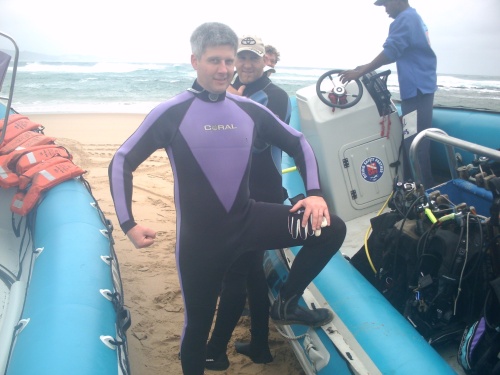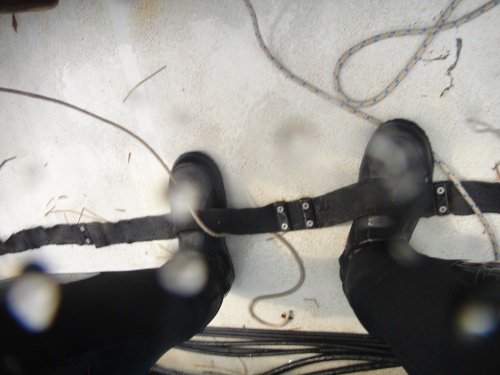Cape Town water is not warm. The Atlantic ocean’s temperature ranges between 8 and 13 degrees, while False Bay can be anywhere between 10 degrees (very unusual) to 20 degrees (also rather unusual, and generally combined with visibility that can be measured in centimetres rather than metres), with an average somewhere around the 15 degree mark.
Being cold increases your risk of decompression sickness, and it makes you stupid and slow, and hence a danger to yourself and your buddy. It dimishes your enjoyment of the dive and can lead you to get out of the water when you still have plenty of air and time at your disposal.
Here are a couple of suggestions – tried and tested by Tony, a lifelong warm-water diver, and me, a boat-diving wussy…
Gear
Ah, you say, cold water means you need a drysuit, or at least a nice thick (5mm plus a 5mm shorty on top, or otherwise at least 7mm) wetsuit to keep out the chill. This is true, but there are three other essential components to a Cape diver’s gear that can make a HUGE difference.
Booties
Get thick booties – the thickest ones you can find, especially if you have poor circulation. If you can, wear them with the cuffs inside your wetsuit.
Gloves
Gloves, at least 3mm thick, are essential. Don’t try and dive without them – you won’t be able to operate your camera or inflator hose after a while. Your fingers are not well-insulated. Again, tuck gloves into your sleeves if you can.
Hoodie
The hoodie is actually the most essential part of your gear. While it appears to be a myth that the majority of body heat is lost through your head, if it’s the only part of you that’s exposed, it WILL be the primary source of heat loss. Heat loss through the head increases with exercise up to a point, and like the hands, your head is not well insulated for the most part.
When Tony moved to Cape Town from Mozambique a year ago, he was quite resistant to wearing a hoodie, and got very, very cold (almost paralysed after a dive… not good) for the first while. He found a loose hoodie (not attached to his wetsuit) that didn’t make him feel restricted, and we are now able to do one hour dives in 12 degree water with relative ease (as long as we don’t sit around TOO much). I think this has been the greatest assistance to him in adapting to the 10 degree lower temperatures here, compared to further north.
Other techniques
A couple of other techniques that have worked for us…
Move about
If you get cold, swim a bit. We tend to stay still for longish periods, interacting with fish or taking photos or just looking, and this tends to cause one to get cold quite fast. Go for a short swim when you start getting chilled – it makes a big difference.
Wear a jacket on the boat ride
One of those cheap and nasty anoraks with a white flannel lining can transform your boat ride – specially the ride back to the slipway, after you’re wet. Put it on straight over your wetsuit. This can make a huge difference as it almost eliminates wind chill on your torso.




Re: Other techniques of staying warm.
One natural area of losing heat is obviously where one sweats – i.e. the arm pits! To stay warm one can swim with arms crossed over in front of the body. This means that you must be able to set your buoyancy correctly. Using ones arms for control is normally a sign of bad buoyancy control, so set your buoyancy correctly, cross your arms and stay warm.
By: Andre on 28 December 2010
at 0927
[…] 2009. He’s used to the warm seas of Jordan, Sodwana and Mozambique, and while False Bay is chilly but tolerable, he found the Atlantic unbearable. Dives like this one, however, have been changing his mind. […]
By: Dive sites: BOS 400 « Learn to Dive Today on 1 January 2011
at 1229
[…] Neoprene also breaks down eventually, it becomes waterlogged and looses its density and insulation properties. It now feels like a 3mm wetsuit and I get cold. […]
By: Wetsuits and drysuits « Learn to Dive Today on 1 February 2011
at 0848
[…] water affects one’s body temperature when wearing a wetsuit (two 5 millimetre layers, plus a hoodie and gloves). I’ve been trying to remember to take a thermometer with me to dives for months, and finally […]
By: A very scientific experiment « Learn to Dive Today on 1 March 2011
at 0713
[…] the same ones Tony has been wearing for a while, and have made a huge difference to his overall warmth in the cold Cape water. They’re 5 millimetres thick with very rugged soles, perfect for shore dives and the kind of […]
By: These boots are made for diving « Learn to Dive Today on 27 May 2011
at 1655
[…] Try to stay warm. A by-product of your body’s reaction to cold is urine. Wearing a warm chicken vest under your wetsuit may save you from having to empty your bladder while underwater. Make sure you have good gloves, thick booties and a decent hoodie. On the boat, stay out of the wind if you can, wear an anorak and a beanie or cap. […]
By: Wetting your wetsuit « Learn to Dive Today on 27 May 2011
at 1656